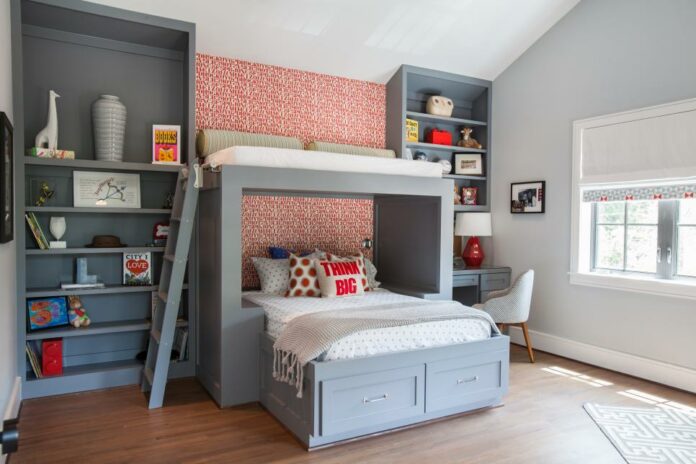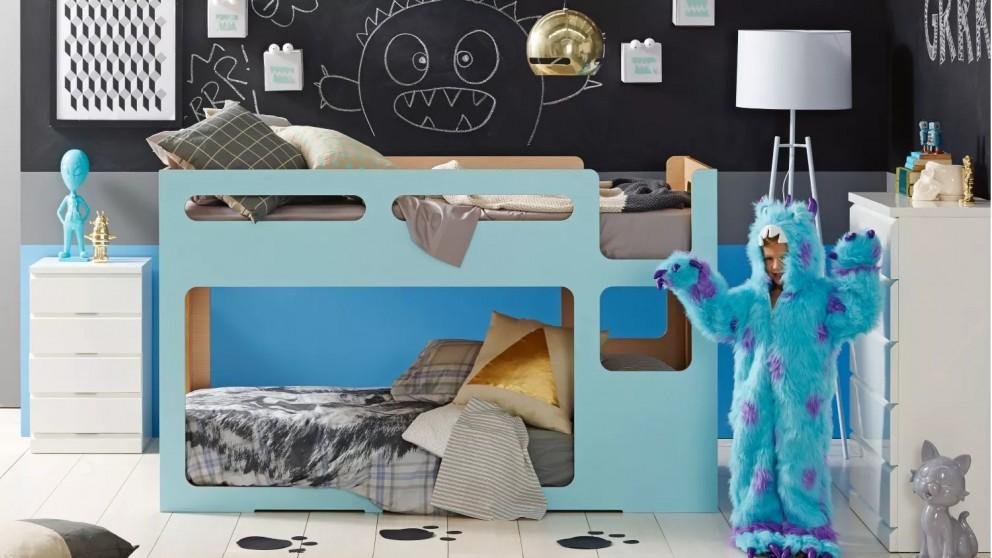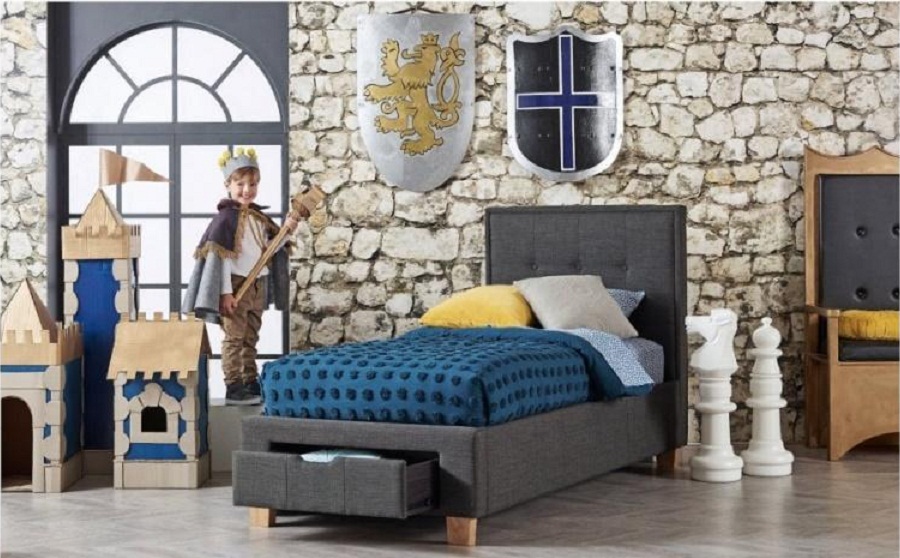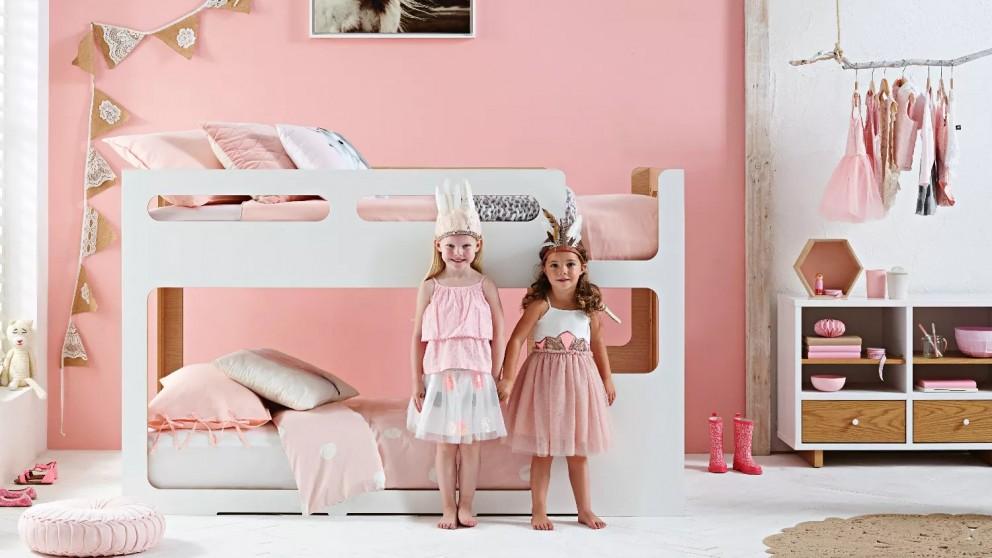Looking to maximise and set up a bedroom perfectly for your kids using bunk beds? We have you covered. Sure, setting up bunk beds in a small bedroom takes a bit of extra planning, but the result can be a fantastic room that will create lasting memories.
When space is limited, bunk beds are a lifesaver in kids’ rooms. Bunk beds use the typically underused vertical space in a bedroom, which instantly frees up floor space for other items. Good layout planning of a small bedroom ensures that each inch is accounted for.
Arranging the space and bed
As you may have seen from samples online, bunk beds for kids function more effectively and safely when they are placed against a wall, rather than kitty-cornered. Placing the bunk bed against the wall leaves open space in the middle of the room and allows the wall to be used for shelving or other storage in the floor space. Because bunk beds use vertical space, they are better suited for empty walls and not on walls with windows; doing so can make a space seem smaller. Try placing the bed on the wall opposite the door to easily make it a focal point without the risk of crowding the entryway.
Under-Bed Storage
The space beneath the top bunk or even the bottom bunk can be used for storage. The under-bed space is great for hiding away a bureau that can otherwise crowd a room.
Also, a more kid-friendly approach is to swap out a traditional bureau for cube-style storage units and cloth bins. Older children who require a homework space can also benefit from under-bunk space ideal that can have a desk; just make sure to add appropriate desk lighting to lessen eye strain. You can make the space even more work-friendly via a hanging a curtain from the top bunk frame.
Shared Rooms
In some cases, bunk beds are a great solution for shared kids’ rooms. When the bottom bunk space is used for a second child, bunk design creativity is an option. Instead of a traditional bunk bed, it’s also possible to go for L-shaped bunk bed, wherein the bottom bed sits at a right-angle to the top bunk. If you want the traditional one like the one the image above, it can also work amazingly in the top center of a room, where you can also create a small alcove under the top bed for use as bookshelf or desk.
Another great option is to look for a bunk unit with a tuck-away bed on the bottom; these types of bunks have beds that slide underneath the top bunk when it’s not being used.
Built-Ins
If you have your house is pre-planned, you can take advantage of creating a built-in bunkbed beforehand. These types of beds are framed out to look like alcoves cut into the wall. This results in a visual impression that the beds are out of the way, which effectively makes the middle of the room free from any obstruction. Children are also charmed by built-ins since they can be decorated with trim, recessed lighting or paint for a personalized touch.
How to Choose a Bunk Bed for a Small Space
When choosing the best bunk beds, taking measurements is essential. While there are ready-made bunk beds, there are also customized ones. You have many options, such as buying bunk beds online or in physical furniture stores. Tiny space BIG LIFE offers bunk bed ideas and reviews if you want to check out which options suit your space. It’s important to carefully select the right bunk beds and here are factors you should consider:
- Bunk Bed Material: Choose solid wood. As much as possible, get away from processed woods or particleboards made of wood flakes that are glued together. For greater longevity, choose solid wood bunk beds that offer the same stability for safety.
- Separate or Combined Bunk Beds: Determine if you want separate bunk beds for more styling options or a combined one.
- Height Between Beds: The height between the top and the bottom bunks needs to be enough. Considering this factor will allow your children to comfortably move around and sit without hurting or hitting their head. You might also want to dedicate space for you to sit on the bunk bed by adjusting its height whenever it’s story-time for the kids.
- Height of the Bunk Bed to the Ceiling: Make sure there’s enough room for the sleeper on the top bunk so they can sit around and move without worry.
- Stairs or Ladders: For younger children, stairs are recommended. Older children can move safely in ladders, which also save space.
- Color: Bunk beds come in various colors, like wood tones, gray, white, and pink.
Consider Trundle Beds for Guests and Storage: A trundle bed is a good idea underneath the bottom bunk. It will help sleepover guests find an excellent place to stay for the night. Also, adding drawers can solve your storage problems for toys or bedding.
End Note
There you have it! These are just some of the things you can do to set up your kid’s small bedroom effectively using bunk beds for kids. You can find out more about kids bunk beds online through Domayne where you can compare models and read user reviews. Check them out!





















